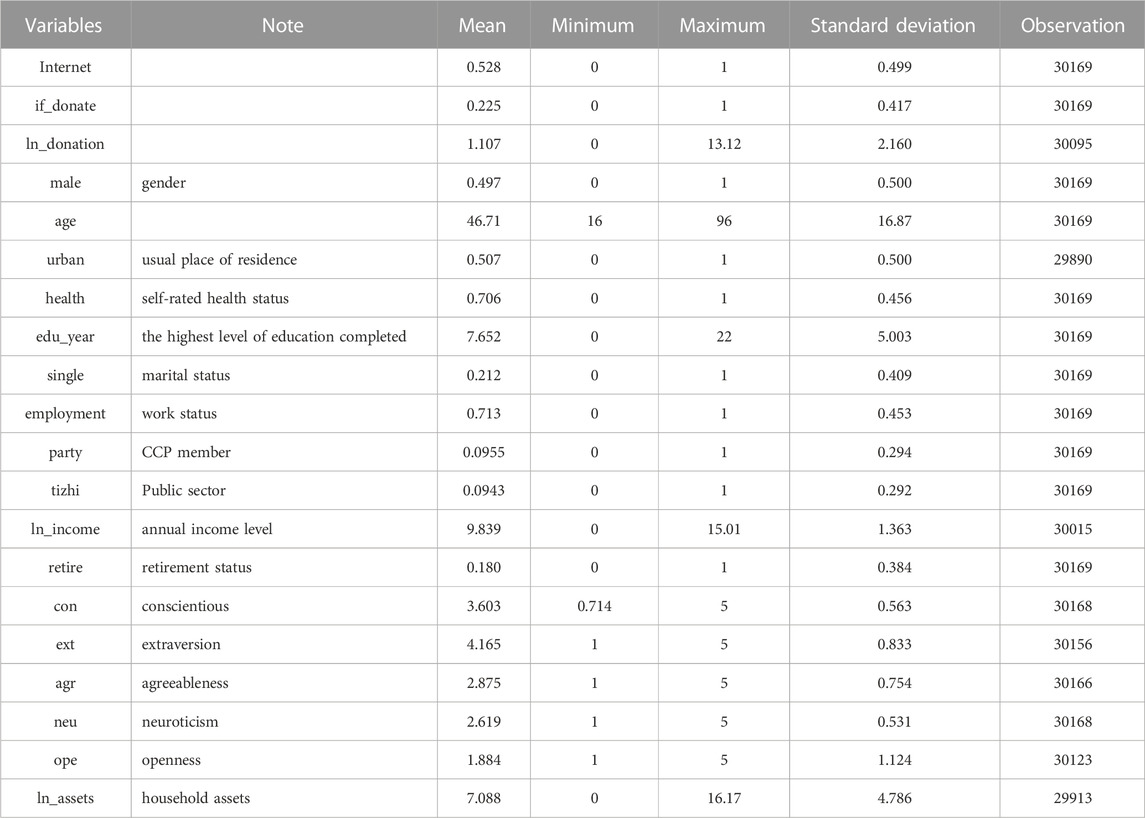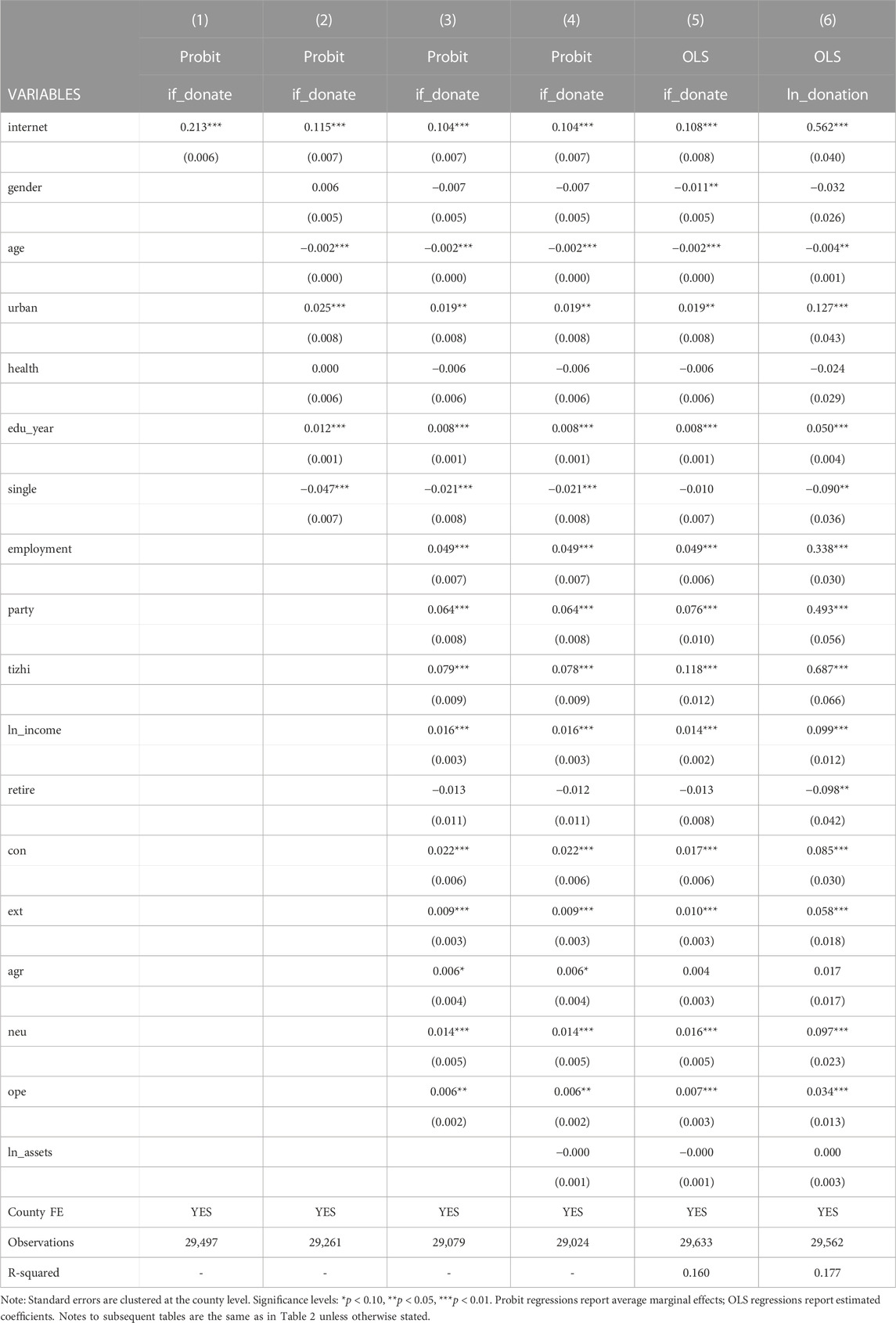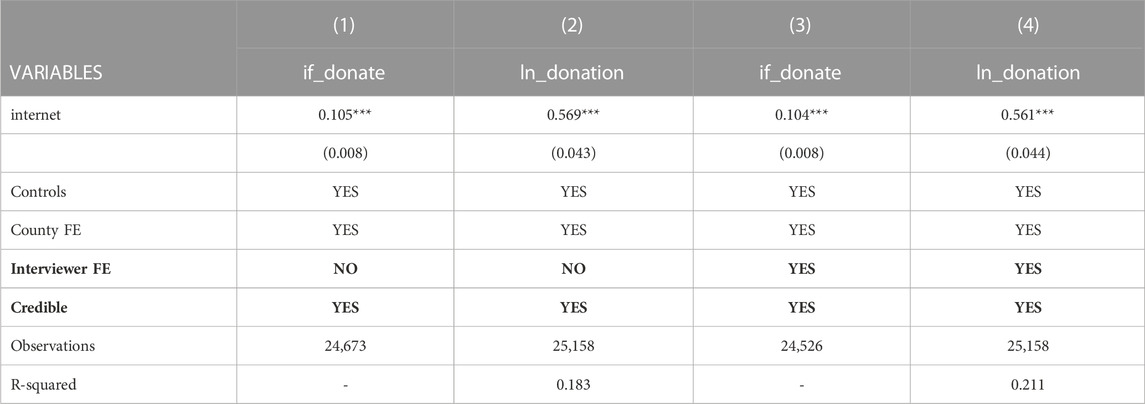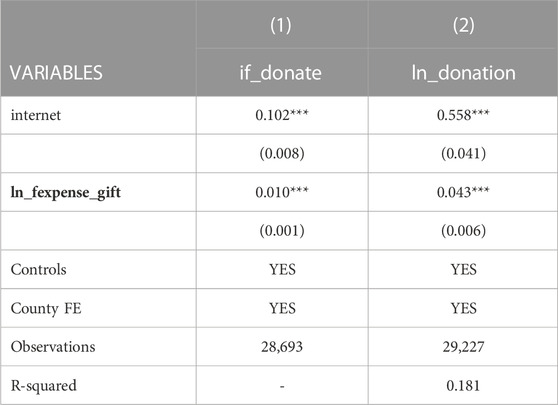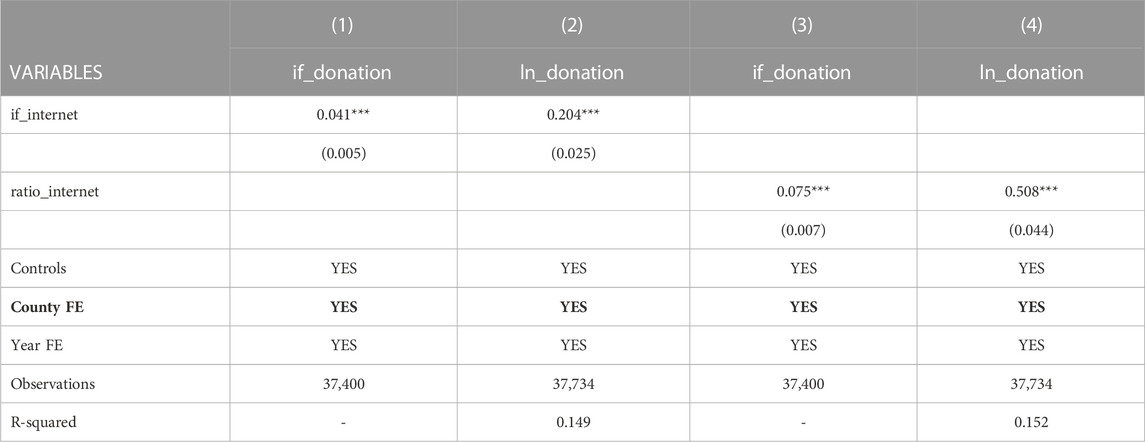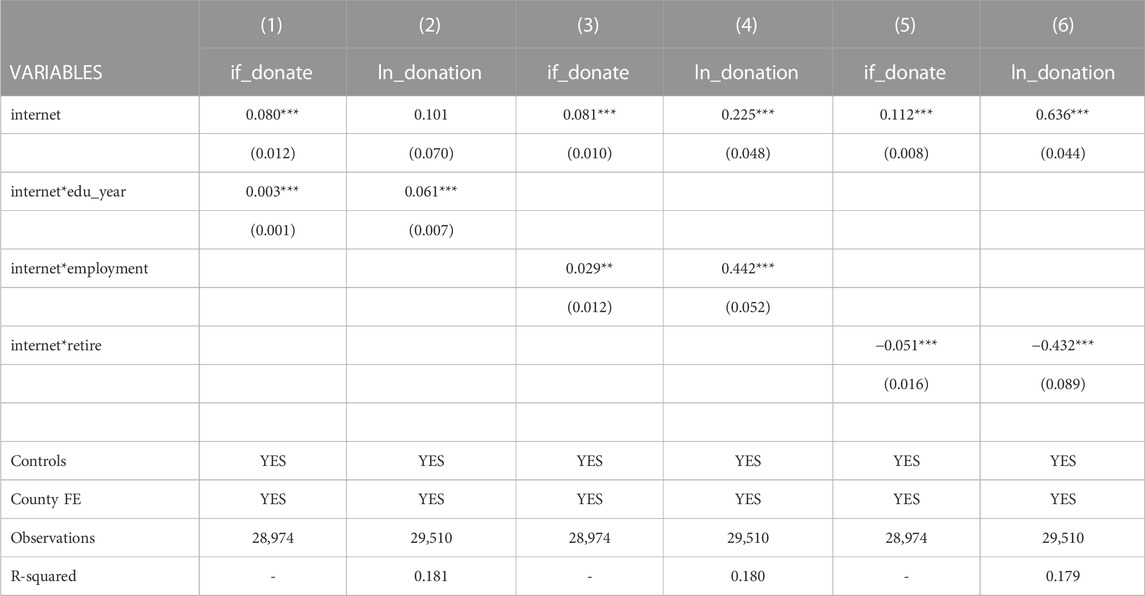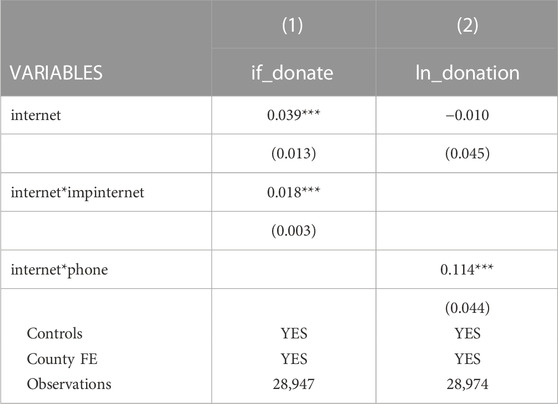- 1School of Economics, Central University of Finance and Economics, Beijing, China
- 2China Center for Internet Economy Research, Central University of Finance and Economics, Beijing, China
With the development of digital economy, especially the Mobile payment, the lifestyles such as the private donation, is undergoing accelerated changes in the last decades. Based on the China Family Panel Studies 2018 data, this paper systematically investigated the donation models, empowered by digital technology, have realized economy system refinement and intelligent development. Compared with residents who do not use the Internet, residents who use the Internet are about 10% more likely to donate, and the amount of donations will increase by about 56%. After considering the potential endogeneity problem, results still hold with Propensity Score Matching (PSM) and Instrumental Variable. The mechanism analysis shows that the searching cost and information asymmetry play an important role. The research of this paper has enlightening that the widespread use of digital technologies can effectively change the private donation behavior and penetrate energy consumption via dramatically decreasing searching cost.
1 Introduction
With the development of Internet and Mobile Payments, there are around 800 million Mobile payment users according to the Statistical Report on Internet Development in China released by the China Internet Network Information Center in Figure 1. At the same time, according to the China Charitable Giving Report, the total amount donated by private has sharply increased from 267 billion yuan to 524 billion yuan in the last decade, showing an increasing trend in private donations but a relatively stable trend in social charities from enterprises (Figure 2). Coincident events hint at whether there is a relationship between them. This paper aims to explore the possible link between these two trends and investigate the factors that may influence individual donation behaviors in the digital age.
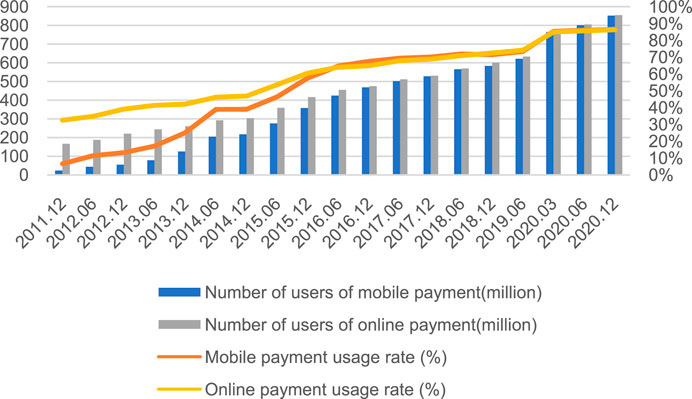
FIGURE 1. The scale and usage rate of online/mobile payment users in China (2011–2020). Source: The Statistical Report on Internet Development in China released by the China Internet Network Information Center (CNNIC) over the years.

FIGURE 2. The amount and ratio donated by private and firms in China (2011—2020). Source: The China Charitable Giving Report, which is an annual series of reports on China's charitable giving commissioned by the Ministry of Civil Affairs.
Recent literatures show that information asymmetry (Chen, 2021) and donation cost (Liu et al., 2021), such as transportation cost and time cost, are the main obstacles to private donations. Even though the Internet and Mobile payment can help us cross the above hurdles, there are also traps in online donations. Take Waterdrop as an example, this platform was officially established in July 2016. By the end of 2021, about 394 million users had donated over 48.4 billion yuan ($6.94 billion) to nearly 2.4 million seriously ill patients through the platform. Unfortunately, however, the Waterdrop was exposed by the media last year for its “gray chain” problem1. It was reported that intermediaries on Waterdrop were conducting malicious promotions with commission rates of 30%–70% on fundraising intermediaries. Therefore, it is unclear whether the effect of the Internet on personal donation is significantly positive or not.
On the one hand, the popularity of the Internet has a positive impact on charitable fundraising in terms of both openness and convenience. Firstly, as for openness, digital technology upgrading has provided diverse channels for charitable organizations to disclose information, which helps solve the trust challenges faced by traditional charitable giving (Gandia, 2011; Blouin et al., 2018). The specific content of donation projects, including the number of donations, the number of donors, the progress of donation projects, the source and destination of funds, and other information can be disclosed in real-time through the Internet, which also makes it timelier and more convenient for all kinds of the government sectors to grasp the situation, so as to monitor more effectively. Secondly, as for convenience, mobile payments such as Alipay and WeChat have broken through the geographical, spatial, and crowd restrictions of traditional charity fundraising (Zheng, 2020), greatly facilitating the operation of donations by residents. Participation enthusiasm is reinforced, due to the ease and convenience of use (Boden et al., 2020). In addition, against the important backdrop of addressing climate change and achieving sustainable development (Yu et al., 2021; Guo et al., 2023; Wang et al., 2023), the popularization and promotion of mobile payment can promote the development of a low-carbon economy, further promoting low-carbon living.
On the other hand, the popularity and widespread use of the Internet may have a negative impact on donations. Firstly, there are frequent incidents or suspected incidents of fraudulent or deceptive use of crowdfunding on the internet (Zenone and Snyder, 2019), especially in China. Because China’s existing Charity Law does not cover the activity of Internet fundraising and current crowdfunding platforms generally have low requirements for originators’ qualifications (Ke, 2017). Secondly, because of the anonymity and rapidity of information dissemination on the Internet, the cost of creating and spreading rumors is greatly reduced (Vosoughi et al., 2018; Zhang et al., 2022). It is difficult to figure out rumors. Residents’ enthusiasm to make charitable donations are reinforced.
Overall, the development of the Internet has had a significant impact on residents’ charitable activities, but its ultimate impact remains to be studied in depth. The role of digital technologies in influencing residents’ willingness to donate has been explored in the literature, but mainly in the context of population-specific studies of donation behavior and willingness (Andreoni et al., 2003; Bryant et al., 2003; Meer and Rosen, 2013; Meer and Priday, 2021), or using experimental methods for analysis (Chen et al., 2005; Ingenhoff and Koelling, 2009; Castillo et al., 2014), which did not include the analysis of large-scale, more representative samples. And the reliability of the study’s conclusions still needs further verification. In particular, the paper of Gao and Wang (2021) is similar to the topic of this paper, but they use data from the 2012 Chinese General Social Survey (CGSS) and find that using the Internet makes residents more willing to give and that residents’ volunteer participation, social networks, and sense of giving all play moderating roles in charitable giving. It is important to note that, first, the data used in this paper are from 2012, which is relatively outdated compared to the booming Internet philanthropy, because neither the coverage of the Internet, nor the application of various charity APPs and official accounts is comparable to today2, and the impact of Internet use on residents’ giving has not yet been fully revealed. Second, they do not explore the mechanism by which Internet use affects residents’ donation behavior. Therefore, it is necessary to conduct a more in-depth study of this issue using more representative and current data in order to draw more accurate conclusions.
For the above reasons, this paper systematically investigates the impact of Internet use on residents’ giving behavior using micro-data from the China Family Panel Studies (CFPS) 2018 to draw more precise and relevant conclusions. The results of the study, which control for endogeneity issues, show that residents who use the Internet are about 10% more likely to donate and the number of donations will increase by about 56%. This effect is more pronounced for Internet users who are highly educated, working, and non-retired. Further analysis suggests that Internet use acts on personal donation behavior primarily through two major mechanisms: searching cost and information asymmetry.
This paper may have three marginal contributions in comparison to existing literature. First, we detect the causal effect of digital economy on private donation behavior, which extends our understanding the impact of the digital technologies on residents’ lifestyle, which extends the literature related to the effect of the digital economy and the causal factors of the private donation. Second, this study figures out that possible mechanisms by which using Internet affects residents’ donation behavior. Third, based on the mechanism analysis, we find reducing the transportation cost is a benefit from the development of the digital economy, which is important evidence to sustain the widespread use of digital technologies can effectively penetrate energy consumption.
The remaining part of the paper proceeds as follows. Section 2 contains a literature review; Section 3 describes the data and the identification strategy used in the analysis; Section 4 presents the empirical results as well as the robustness tests followed by heterogeneity analysis; Section 5 further explores the mechanisms involved; and Section 6 concludes.
2 Literature review
It has been shown that people’s willingness and behavior to donate can be influenced by numerous factors. According to the literature, we can classify these influences into two categories: individual and environmental factors.
Individual factors mainly refer to the personal characteristics of the donor, including gender, age, education, income and wealth, and many other aspects. For gender, Andreoni et al. (2003) found that for single households, there was a significant difference between men and women in terms of the amount donated. Böhm and Regner (2013) conducted a real-effort task experiment and found that male subjects increased donation performance in the public setting for the purpose of status-seeking. Lee et al. (2016) verified that donation attitudes were more positive among female than male students and this phenomenon could be interpreted using altruism theory. For age, the empirical literature generally finds that both the probability and amount of donation decrease when the elderly are getting old. Meer and Rosen (2013) confirmed that under the same assumptions, the manner in which older adults die also had an impact on donation. For education, Bryant et al. (2003) observed that individuals with high human capital were more willing to donate based on the survey data from 1994. For income and wealth, Meer and Priday (2021) used panel data on income to empirically test that donation behavior increases as individuals’ income and wealth increase.
Environmental factors, on the other hand, emphasize that the external environment in which individuals live plays a role in influencing donation behavior through structural forces such as infiltration or coercion. These factors include family environment, cohort effect, social capital, and geographical proximity. For the family environment, Lee et al. (2016) identified the relative impact of parent-related factors, including parents’ donation activity and volunteer work, on middle school students’ donation attitudes. For the peer effect, Meer (2011) focused on it in the solicitation, looking at whether people give more if the ask comes from someone they know. Smith et al. (2015) empirically verified donors were significantly influenced by the donations of their peers in the context of individual online fund-raising. For social capital, Brown and Ferris (2007) found a strong correlation between social capital on philanthropy through a field experiment, i.e., the higher the stock of individual social capital, the higher the level of donation. Saxton and Benson (2005) showed that by controlling for other relevant social, political, and economic factors, communities with higher levels of social capital experience more extensive growth in their nonprofit sectors. For geographical proximity, the sense of geographical proximity believing that recipients come from the same area had a strong correlation with an individual’s donation behavior (Guéguen et al., 2018).
In terms of the research topic of this paper, there are a number of studies. However, the literature studying charitable giving from the Internet perspective has mainly focused on experimental studies rather than empirical studies. This is because the popularity of the Internet provides a more convenient platform and channel for conducting donation experiments (Chen et al., 2005). Chen et al. (2005) implemented the first web-based online fundraising experiment to test the effectiveness of various fundraising mechanisms. Ingenhoff and Koelling (2009) used charitable fundraising nonprofit organizations (NPOs) experiments to demonstrate that the Internet increases the likelihood of public participation in dialogue by providing a two-way communication channel for NPOs to communicate with the public. Castillo et al. (2014) implemented a field experiment embedded in an online giving organization’s web page to further explore the impact of incentives on the willingness to fundraise.
It is noteworthy that experiments used to study charitable giving suffer from some common drawbacks. Firstly, the participant pool in experiments is often limited, which restricts the number of variables that can be controlled simultaneously. Secondly, most experiments utilize homogenous samples of students, casting doubt on the external validity of findings based on student populations. Research studies based on random population samples, on the other hand, tend to have large and well-represented samples, which can offset the limitations of experimental research. Nonetheless, there are few studies in this area, with the exception of Gao and Wang (2021). Therefore, this paper utilizes the latest 2018 China Family Panel Studies (CFPS) data to re-examine the impact of Internet use on residents’ donation behavior and provide an in-depth analysis of the relevant mechanisms to bridge the gap in this area.
3 Data and identification strategy
3.1 Data
The data used in the paper are from the China Family Panel Studies (CFPS), which is a biennial survey conducted from 2010 to 2020 and covers 162 counties in 253 of 31 provinces. The sample is nationally representative of Chinese communities, households, and individuals. The explanatory variable in this study is personal donation behavior. In the CFPS individual-level questionnaire, the donation-related questions are asked only in 2018, we have to use the 2018 survey data for benchmark empirical analysis.4 We limit the study to the adult questionnaire and ultimately retain a sample of 30,169 after removing missing values for key variables.
Personal donation behavior—The dependent variable is the donation behavior of residents. We use two indicators to characterize this. Firstly, we construct a dummy variable for whether residents have made a donation, based on the question in the CFPS questionnaire: " In the past 12 months, have you ever made any donation to any individual or organization?” The dummy variable if_donate was constructed to indicate whether or not the resident had made a donation. If the answer is yes, then the variable takes the value of 1, otherwise, it takes the value of 0. Secondly, we constructed the continuous variable ln_donation5 to characterize the amount of money donated by residents based on their responses to the question “What is the total amount of donation in the past 12 months? ". What’s more, if the question is limited to “in the past 12 months”, it will be 1 year backward from the survey time. Therefore, the donation data used in the benchmark regression in this study refers specifically to the time period from June 2017 to June 2018. The CFPS data does not record each individual’s donation transactions, but report each‘s donation decision and total amount in the last 12 months. (Supplementary Table A2).
Internet service - The independent variable is the Internet usage of residents, which is a dummy variable. Based on two questions “Do you use mobile devices (e.g., mobile phone, tablet PC) access to the Internet?” and “Do you use computer access to the Internet?“, if the respondent answer “yes” for either of above two questions, this variable is assigned the value of 1, otherwise, this dummy variable is set a value of 0.
Other control variables - According to the previous literature (Bronars and Lott, 1997; Yang et al., 2020; Andreoni et al., 2003; Meer and Rosen, 2013; Bryant et al., 2003; Meer and Priday, 2021), we also controlled for a range of personal and household characteristics variables in order to exclude other influences. The personal characteristics variables include the respondent’s gender (1=male; 0=female), age, years of schooling (refer to the highest level of education completed6), marital status (1=unmarried, divorced or widowed; 0=married or cohabiting), work status (1=employed; 0=unemployed, including withdrawal from the labor market), self-rated health status (1=very good; 0=very poor), usual place of residence (0=rural; 1=urban), annual income level (logarithmic form), CCP member (1= the member of Communist Party of China; 0=not), public sector7 (1=public sector; 0=private sector), and retirement status (1=retired; 0=not). What’s more, Personality traits are a more comprehensive portrayal of a person’s traits (Almlund et al., 2011; Heckman, 2011) and these may be important variables. We constructed five major personality trait variables, namely conscientious, extraversion, agreeableness, openness, and neuroticism based on the NEO personality trait revision questionnaire developed by Costa and McCrae (2008) and the questions from the British Household Panel Study (BHPS) (Brown and Taylor, 2014), and then add ‘Big five’ personality trait in the main model.8 Household characteristics variables are then added by using household assets (containing cash, savings, and financial products, in logarithmic form).
Table 1 presents the summary statistics of individual cross-sectional data. As shown in Table 1, 53% of residents accessed the internet via computer or mobile. This figure is largely consistent with the Internet penetration rate of 59.6% in 2018 published by CNNIC, indicating that the use of CFPS data to study internet use is relatively representative. In addition, in terms of donation behavior, nearly a quarter (22.5%) of respondents made donations in 2018, with the average donation amount of all samples being 99.97 yuan ($14.36), accounting for 0.69% of individual income.9
3.2 Identification strategy
In the baseline regression, this paper uses a Probit model to investigate the effect of Internet use on whether residents make donations. The model was set up as follows.
In Equation 1, the explanatory variable
For the amount of donation, this paper uses ordinary least squares (OLS) for estimation. The model is set up as follows.
In Equation 2, the explanatory variable
4 Empirical results
4.1 Baseline estimates
We present the baseline specification in Table 2, which demonstrates the impact of internet usage on personal charitable giving behavior. The dependent variables are the probability of donating and the amount donated, while the independent variables are internet usage and other control variables. Columns 1–5 of Table 2 display the results for whether an individual made a donation in 2018. The regression analysis demonstrates that the coefficient for internet usage remains significantly positive at the 1% level, even after controlling for individual demographic characteristics, work characteristics, wealth characteristics and personality traits one at a time. This suggests that the positive effect of internet usage on the likelihood of donating is robust. Column 4 of Table 2 shows that residents who use the internet are about 10.4% more likely to donate compared to those who do not use the internet. This figure represents 0.46 times the 2018 average probability of donation (22.5%), which is a highly economically significant result. The results in column 5 are obtained using a linear probability model, and the significance of the estimates is consistent with the Probit model. Column 6 examines the impact of internet usage on the amount donated by individuals in 2018. The regression analysis shows that residents who use the internet donate approximately 56.2% more compared to those who do not use the internet.
4.2 Endogeneity issues
To ensure the reliability of our findings, we implemented several methods to address potential endogeneity concerns. We employed three different techniques to tackle endogeneity issues.
4.2.1 Propensity score matching
Self-selection bias is a bias that is introduced into a research project when participants choose whether or not to participate in the project, and the group that chooses to participate is not equivalent (in terms of the research criteria) to the group that opts out. The treatment groups and control groups are observed in this study. In this study, the donation group is not equivalent to the nonparticipant group because of unobserved characteristics, such as the donation preference or culture. Therefore, the estimation results may be biased, and the baseline regression may overestimate the effect of internet use on donation behavior. To ensure the reliability of the core findings of this study and better reveal the causal relationship between internet use and individual donation behavior, we employed the propensity score matching (PSM) method for handling and compared the difference in donation behavior between these two groups of individuals, namely Average Treatment Effect (ATT), to determine the effect of Internet use on personal donation behavior.
The results of the balance test showed that the differences between the control variables in the experimental group and the control group were significantly reduced after matching, and most of the covariates’ significance disappeared, meeting the requirement of covariate balance between groups. Table 3 reports the results of the ATT calculated using the nearest neighbor matching method. It can be seen that compared with residents who do not use the Internet, Internet use increases the probability of donation by approximately 10.2% and 11.5%. The effect of Internet use on donation behavior remains siginificant at the 1% level after using PSM for matching, consistent with the conslusion in Table 2. The results indicate that the problem of self-selection bias does not have a significant impact on the regression results.
4.2.2 Measurement errors
To address the issue of potential measurement errors, we removed questionnaires with low credibility scores. Based on the observations of the CFPS interviewers, the respondents’ impatience with the interview was scored on a scale of 1 (very low) to 7 (very high) to measure the credibility of the sample. We used a mean score of 4 as the criterion to determine whether the respondent was impatient, and if the score was higher than 4, the value of “Credible” was set to 0. This is because if the interviewer gave a score higher than 4, it means that the respondent is more likely to choose quick answers in the preceding questions, rather than providing truthful answers. For example, when asked “Do you use a computer to access the internet,” if the respondent answers “yes,” further questions will be asked about the frequency of internet use for study and work, but if the respondent answers “no,” there will be no related follow-up questions. Therefore, it is possible that the quality of the information provided by the respondent may be compromised due to impatience with the interview, leading to measurement errors.
On the basis of the baseline regressions, we removed samples with scores greater than 4, representing approximately 15% of the total sample. The results in columns 1 and 2 of Table 4 validate the robustness of our conclusions. The measurement errors are unlikely to drive our estimates spuriously.
Besides, to address concerns about comparability of subjective scoring across interviewers, we also control the interviewer fixed effect, the results in columns 3 and 4 of Table 4 are still robust.
4.2.3 Instrument variable
If generous donors are inherently more likely to be online, then distinguishing whether Internet use increases giving behavior or whether Internet use is due to generous giving will be very difficult. To eliminate this potential endogeneity problem, we introduce the instrumental variable, drawing on the idea of constructing instrumental variables from Gao and Wang (2021). We selected the average internet usage of all respondents within the same county excluding the respondent himself/herself as the instrumental variable for respondents’ internet usage. The level of Internet access and utilization in a region has a significant impact on individuals’ decisions to access the Internet, and the regional use of the Internet is strongly exogenous to residents’ donation behavior, so it is reasonable to use the regional average Internet use as an instrumental variable. Based on the characteristics of the explanatory variables, we conducted IV-Probit regression and IV-2sls regression respectively, and the regression results are shown in Table 5.
The result of the first-stage estimates is reported in Panel B of Table 5. It can be seen that as the explanatory variable, the first-stage regression coefficient of internet use is significantly positive at the 1% level, indicating a significant positive impact of average Internet use in county areas on whether individuals use the internet. Therefore, the instrument variable has a strong correlation. The first-stage F-values were 501.25. According to Stock and Yogo (2005), the critical value of the F-value is 16.38 under the assumption that the bias level is less than 10%, which further demonstrates the explanatory power of regional average Internet usage for whether individuals use the internet, and there is no weak instrument problem. The second stage results from Table 5 report that the regressions using instrumental variable are generally consistent with the baseline estimates: a 17.6% increase in the probability of donation for residents who use the internet in the IV-probit regression; and a 18.1% increase in the probability of donation for residents who use the internet in the IV-2sls regression.
4.3 Robustness tests
4.3.1 Expenditure on gifts for social relation
Expenditure on gifts for social relations, as the cost of interaction between people, has the function of maintaining long-term relationships between acquaintances. This is different from the act of donation, but it is easy to confuse household favor expenditure with donation expenditure. In particular, favor expenditure from wealthy families to poorer families may have both social capital attributes and donation attributes, unlike general donation expenditure. Therefore, in order to exclude the effect of this type of expenditure on the conclusions, we selected the corresponding question from the CFPS household questionnaire, “In the past 12 months, what was the total amount of money your family spent on gifts for social relations? " to measure Expenditure on gifts for social relations and included this control variable ln_fexpense_gift in the main model. The regression results in Table 6 report that the internet’s ability to significantly increase the probability and amount of giving still holds after controlling for household spending on favors. Our main findings remain unchanged.
4.3.2 Household panel data
It has been proved that charitable giving tends to be made by households as a unified economic entity, with joint decision-making by couples being the dominant way (Wiepking and Maas, 2009). The giving behavior we see may not only be the individual decisions, but also the behavior of households. Therefore, we use the household panel data below to analyze the impact of internet use on giving behavior.
In the CFPS household-level questionnaires, the household donation information and internet usage are recorded in 2014, 2016, and 2018. So, this panel data from these three periods is conducted to make the robust test. The final sample contained 40,580 observations after removing missing key variables. Referring to the study by Yang et al. (2022) and Guo (2020), we examined household internet use in two dimensions. The first variable if_internet is whether the household uses the Internet, taking a value of 1 to indicate that at least one person in the household uses the Internet and 0 to indicate that no one in the household uses the Internet; the second variable ratio_internet is the household Internet usage rate, which is the ratio of the number of people using the Internet to the number of all people in the household. We constructed the continuous variable ln_donation10 based on the responses to the economic questionnaire " In the past 12 months, how much social donation did your family make in cash and in kind (e.g., food and clothes)?". The continuous variable was used to characterize the amount donated by households. The dummy variable if_donate was constructed to indicate whether or not the household made a donation. The control variables include the personal characteristics of the household financial manager and household characteristics, including gender, age, education, marital status, work status, CCP member, public sector, annual household income, household assets, time fixed effect and county fixed effect. Table 7 reports summary statistics for the main variables at the household level.
Table 8 presents the results of the effect of household-level Internet use on giving behavior. The results in column 1 of Table 8 show that Internet use increases the probability of household giving by 4.1%. The results in column 2 indicate that households using the Internet are 20.4% more likely to donate compared to households not using the Internet. This suggests that the positive impact of internet use on donation behavior remains robust even at the household level. The regression results in columns 3 and 4 of Table 8 also report that an increase in household internet usage rate increases the probability of giving and the amount given by households.
4.4 Heterogeneity analysis
The benchmark regression results show that internet usage can increase the probability of residents’ donations, but differences in individual characteristics may lead to variations in this relationship. Based on the benchmark regression, we introduced interaction terms between years of education, employment status, retirement status, and internet usage, respectively, to investigate whether the impact of internet usage on resident donation behavior varies significantly due to differences in human capital and income.
Columns 1 and 2 of Table 9 show that highly educated Internet-using individuals are 0.3% more likely to give than less educated Internet-using ones and give approximately 6.1% more; columns 3 and 4 examine that working Internet-using residents are 2.9% more likely to give than non-working Internet-using ones and the number of donation are 44.2% higher; columns 5 and 6 indicate that retired Internet users are 5.1% less likely to give than non-retired Internet users, and money donated is 43.2% less. As expected, Internet use has a greater positive impact on the giving behavior of highly educated, working, and non-retired residents. These differences may be explained by the fact that better-educated residents are more likely to be influenced by information on the Internet to give because of their mindset and values, and that working and non-retired Internet users are more likely to donate because of their financial abundance.
5 Mechanism analysis
As discussed in Section 4, Internet use has a significant positive impact on personal donation behavior. In this section, we will specifically examine the mechanisms through which the Internet promotes giving. From the perspective of the Internet’s own functions, its underlying mechanisms for influencing giving include the following two, namely information asymmetry and searching cost.
5.1 Information asymmetry
Information asymmetry between donors and recipients is an important factor limiting the development of charitable fundraising (Chen, 2021). Before the popularity of the Internet, it was often difficult for donors to know details about donation projects, including the number of donations, the progress of donation projects, the source and destination of funds, or even where potential recipients were located. In December 2011, there were 446,000 registered civil society organizations in China, with less than 5% of public welfare organizations able to disclose information comprehensively and on time.11 The rapid development of the Internet has provided low-cost and diversified channels for information disclosure for charitable organizations, greatly alleviating the information asymmetry phenomenon (Gandia, 2011; Blouin et al., 2018). Taking the One Foundation initiated by Jet Li as an example, it has disclosed various reports such as annual audit reports on its official website. In addition, donors can check the use of donations and the implementation of projects in real-time on the One Foundation’s official website. Each donor can also apply for invoices on the website. Therefore, we believe that the information mechanism that alleviates information asymmetry is the first mechanism through which the Internet influences individuals’ giving behavior.
5.2 Searching cost
Access to the Internet has largely reduced the information searching cost of donors (Daurer et al., 2012) which can address information asymmetry to some extent. Besides, the popularity of the Internet can also reduce the participation cost of donations, including time, transportation, and transaction costs, making charitable giving more efficient. Both searching cost and participation cost can be seen as opportunity costs of giving, and when such opportunity costs are too high, donors may eventually choose not to give. However, the internet can greatly reduce the opportunity cost of giving and thus facilitate giving behavior. We refer to this mechanism as searching cost.
In order to test the validity of these two mechanisms, we introduced two interaction terms in the main model. Firstly, we introduced an interaction term of two dummy variables, which are the importance of the Internet and Internet use, to test the validity of the information asymmetry mechanism. The individuals’ responses to the question “How important is the Internet as a communication path for you?” is used to construct the dummy variable to characterize the importance of the Internet. All respondents were asked about the importance of the Internet, even individuals who did not use it. Around 12.78% of the individuals who do not use the Internet point out that the Internet is an important source of access to information (Supplementary Table A3). The logic is that if the Internet is more important to a resident’s access to information, then the role of the Internet in mitigating information asymmetries will be greater for him/her, and the marginal impact of the Internet on personal donation behavior should be greater.
Second, there are differences in the convenience level between computer accessing to the Interne and mobile phone accessing to the Internet. Straightforwardly, the searching cost is different. In this part, we include the interaction term between the dummy variable Internet usage and the dummy variable phone usage. We can separate study sample into four groups: mobile internet users, mobile non-internet users, non-mobile internet users, and non-mobile non-internet users.
The estimates for the two mechanisms are presented in Table 10. The coefficients of all the interaction terms are significantly positive, indicating that the information asymmetry mechanism and the searching cost mechanism are indeed all significantly present. The result in column 1 of Table 10 shows that among individuals who use the internet, those who regard the Internet as important are more likely to donate. It can also be observed that among individuals who use the internet, using a mobile phone can significantly increase their probability of making donations (Column 2 of Table 10).
6 Conclusion
With the widespread of digital economy, the number of Mobile payment users and the amount of private donation increased simultaneously in the last decades. The donation models, empowered by digital technology, have realized more openness and more convenience. But the popularity and widespread use of the Internet may have a negative impact on donations in terms of both incidents and rumors. Therefore, the study of residents’ new lifestyle, such as donation behavior, has important practical significance and theoretical value. Based on the China Family Panel Studies (CFPS) data, we systematically investigate the impact of digital technologies on residents’ donation behavior and explores its mechanisms. The research in this paper finds that Internet use largely increases the probability of donation and the amount of donation among respondents. Residents who use the Internet are 10% more likely to donate and approximately donate about 56% more than residents who do not use the Internet. This effect was more pronounced for highly educated, and working users, as well as those who are non-retired. Further, we propose and validate two mechanisms by which the Internet influences residents’ donation behavior: searching cost and information asymmetry, in terms of the basic functions of the Internet. The research of this paper has enlightening that the widespread use of digital technologies can effectively change the private donation behavior and penetrate energy consumption via dramatically decreasing searching cost.
Data availability statement
Publicly available datasets were analyzed in this study. This data can be found here: http://www.isss.pku.edu.cn/cfps/index.htm.
Author contributions
XL, YS, and TT contributed to conception and design of the study. TT organized the database. YS performed the statistical analysis. TT wrote the first draft of the manuscript. XL and YS wrote sections of the manuscript. All authors listed have made a substantial, direct, and intellectual contribution to the work and approved it for publication. All authors contributed to the article and approved the submitted version.
Funding
This work was supported by Major Programs of the National Social Science Foundation of China (No. 21ZDA032), the Beijing Outstanding Young Scientist Program (No. BJJWZYJH01201910034034) and the Natural Science Foundation of Beijing Municipality (No. 9212018).
Conflict of interest
The authors declare that the research was conducted in the absence of any commercial or financial relationships that could be construed as a potential conflict of interest.
Publisher’s note
All claims expressed in this article are solely those of the authors and do not necessarily represent those of their affiliated organizations, or those of the publisher, the editors and the reviewers. Any product that may be evaluated in this article, or claim that may be made by its manufacturer, is not guaranteed or endorsed by the publisher.
Supplementary material
The Supplementary Material for this article can be found online at: https://www.frontiersin.org/articles/10.3389/fenvs.2023.1195114/full#supplementary-material
Footnotes
1Refer to the website here: https://m.thepaper.cn/baijiahao_19561245.
2Online fundraising platforms are currently an important way for residents to donate, and were only approved by the Ministry of Civil Affairs starting in 2016.
3Tibet, Qinghai, Xinjiang, Ningxia, Inner Mongolia, Hainan, Hong Kong, Macau, and Taiwan are not included.
4We also conduct a robustness analysis later by using household panel data.
5This variable is processed by adding 1 and then taking the logarithm form.
60=Illiterate/semi-literate 6=Primary school 9=Junior high school 12=Senior high school/Vocational School 15=3-year college 16=4-year college/Bachelor’s degree 19=Master degree 22= Doctoral degree.
7Public sector refers to working in Government, Party, People’s organization, Military, State-owned, or Collectively-owned public institution, State-owned, or State-controlled enterprise.
8The specific criteria for the classification of ‘Big Five’ personality traits can be found in the Supplementary Table A1.
9The average donation amount of the donor sample was 448.52 yuan($64.43).
10This variable is processed by adding 1 and then taking the logarithm form.
11Refer to the website here: http://epaper.zqcn.com.cn/content/2013-05/14/content_14514.htm.
References
Almlund, M., Duckworth, A. L., Heckman, J., and Kautz, T. (2011). “Personality psychology and economics,” in Handbook of the economics of education (Elsevier), 4, 1–181. doi:10.1016/B978-0-444-53444-6.00001-8
Andreoni, J., Brown, E., and Rischall, I. (2003). Charitable giving by married couples who decides and why does it matter? J. Hum. Resour. 38 (1), 111–133. doi:10.3368/jhr.XXXVIII.1.111
Blouin, M. C., Lee, R. L., and Erickson, G. S. (2018). The impact of online financial disclosure and donations in nonprofits. J. Nonprofit & Public Sect. Mark. 30 (3), 251–266. doi:10.1080/10495142.2018.1452819
Boden, J., Maier, E., and Wilken, R. (2020). The effect of credit card versus mobile payment on convenience and consumers’ willingness to pay. J. Retail. Consumer Serv. 52, 101910. doi:10.1016/j.jretconser.2019.101910
Böhm, R., and Regner, T. (2013). Charitable giving among females and males: An empirical test of the competitive altruism hypothesis. J. Bioeconomics 15, 251–267. doi:10.1007/s10818-013-9152-x
Bronars, S. G., and Lott, J. R. (1997). Do campaign donations alter how a politician votes? Or, do donors support candidates who value the same things that they do? J. Law Econ. 40 (2), 317–350. doi:10.1086/467375
Brown, E., and Ferris, J. M. (2007). Social capital and philanthropy: An analysis of the impact of social capital on individual giving and volunteering. Nonprofit voluntary Sect. Q. 36 (1), 85–99. doi:10.1177/0899764006293178
Brown, S., and Taylor, K. (2014). Household finances and the ‘Big Five’personality traits. J. Econ. Psychol. 45, 197–212. doi:10.1016/j.joep.2014.10.006
Bryant, W. K., Jeon-Slaughter, H., Kang, H., and Tax, A. (2003). Participation in philanthropic activities: Donating money and time. J. Consumer Policy 26, 43–73. doi:10.1023/A:1022626529603
Castillo, M., Petrie, R., and Wardell, C. (2014). Fundraising through online social networks: A field experiment on peer-to-peer solicitation. J. public Econ. 114, 29–35. doi:10.1016/j.jpubeco.2014.01.002
Chen, Y., Li, X., and MacKie-Mason, J. K. (2005). Online fund-raising mechanisms: A field experiment. Contributions Econ. Analysis Policy 5 (2). doi:10.2202/1538-0645.1477
Chen, J. (2021). “Analysis on the disclosure problems of accounting information in charitable organizations,” in Proceeding of the 2021 International Conference on Financial Management and Economic Transition (FMET 2021), September 2021 (Paris: Routledge: Atlantis Press), 213–217. doi:10.2991/aebmr.k.210917.034
Costa, P. T., and McCrae, R. R. (2008). “The revised NEO personality inventory (NEO-PI-R),” in The SAGE handbook of personality theory and assessment. Personality measurement and testing. Editors G. J. Boyle, G. Matthews, and D. H. Saklofske (London: Sage Publications, Inc), 2, 179–198. doi:10.4135/9781849200479.n9
Daurer, S., Molitor, D., and Spann, M. (2012). Measuring individual searching costs on the mobile Internet.
Gandia, J. L. (2011). Internet disclosure by nonprofit organizations: Empirical evidence of nongovernmental organizations for development in Spain. Nonprofit voluntary Sect. Q. 40 (1), 57–78. doi:10.1177/0899764009343782
Gao, X., and Wang, S. (2021). Promoting or inhibiting: Internet use and residents' charitable giving. Comp. Econ. Soc. Syst. 1, 93–105. (Chinese). doi:10.3969/j.issn.1003-3947.2021.01.010
Guéguen, N., Lamy, L., and Fischer-Lokou, J. (2018). Does the sense of the geographic proximity of a requester influence donation? Three evaluations in field studies. J. Hum. Behav. Soc. Environ. 28 (2), 193–203. doi:10.1080/10911359.2017.1355291
Guo, D., Li, Q., Liu, P., Shi, X., and Yu, J. (2023). Power shortage and firm performance: Evidence from a Chinese city power shortage index. Energy Econ. 119, 106593. doi:10.1016/j.eneco.2023.106593
Guo, R. (2020). Internet usage and household investment on risky financial assets. Proc. Bus. Econ. Stud. 3 (4). doi:10.26689/pbes.v3i4.1423
Heckman, J. J. (2011). Integrating personality psychology into economics. Cambridge, MA. London, United Kingdom: National Bureau of Economic Research, 17378.
Ingenhoff, D., and Koelling, A. M. (2009). The potential of Web sites as a relationship building tool for charitable fundraising NPOs. Public Relat. Rev. 35 (1), 66–73. doi:10.1016/j.pubrev.2008.09.023
Ke, X. (2017). Internet public welfare crowdfunding: Status, challenges, and responses - analysis based on the background of the "charity Law. J. Guizhou Univ. Finance Econ. 6, 53–60. (Chinese). doi:10.3969/j.issn.1003-6636.2017.06.005
Lee, C. S., Shin, M. H., Lee, Y., and Jang, H. Y. (2016). A study on the factors influencing on young people’s donation attitude: A comparison of school levels. Indian J. Sci. Technol. 9 (43), 1–8. doi:10.17485/ijst/2016/v9i46/107198
Liu, Y., Luo, J., and Zhang, L. (2021). The effects of mobile payment on consumer behavior. J. Consumer Behav. 20 (3), 512–520. doi:10.1002/cb.1880
Meer, J., and Priday, B. A. (2021). Generosity across the income and wealth distributions. Natl. Tax J. 74 (3), 655–687. doi:10.1086/714998
Meer, J., and Rosen, H. S. (2013). Donative behavior at the end of life. J. Econ. Behav. Organ. 92, 192–201. doi:10.1016/j.jebo.2013.06.007
Meer, J. (2011). Brother, can you spare a dime? Peer pressure in charitable solicitation. J. public Econ. 95 (7-8), 926–941. doi:10.1016/j.jpubeco.2010.11.026
Saxton, G. D., and Benson, M. A. (2005). Social capital and the growth of the nonprofit sector. Soc. Sci. Q. 86 (1), 16–35. doi:10.1111/j.0038-4941.2005.00288.x
Smith, S., Windmeijer, F., and Wright, E. (2015). Peer effects in charitable giving: Evidence from the (running) field. Econ. J. 125 (585), 1053–1071. doi:10.1111/ecoj.12114
Stock, J. H., and Yogo, M. (2005). “Testing for weak instruments in Linear Iv regression,” in Identification and inference for econometric models: Essays in honor of thomas rothenberg (Cambridge University Press), 80–108. doi:10.1017/CBO9780511614491.006
Vosoughi, S., Roy, D., and Aral, S. (2018). The spread of true and false news online. science 359 (6380), 1146–1151. doi:10.1126/science.aap9559
Wang, K., Wang, Z., Xian, Y., Shi, X., Yu, J., Feng, K., et al. (2023). Optimizing the rolling out plan of China’s carbon market. Iscience 26 (1), 105823. doi:10.1016/j.isci.2022.105823
Wiepking, P., and Maas, I. (2009). Resources that make you generous: Effects of social and human resources on charitable giving. Soc. Forces 87 (4), 1973–1995. doi:10.1353/sof.0.0191
Yang, Y., Shi, Y., and Zhang, D. (2020). Intergenerational effects on individual charitable donation: An innovative study on philanthropy in China. J. Chin. Sociol. 7 (1), 22. doi:10.1186/s40711-020-00139-2
Yang, C., Zhang, Y., and Wang, S. (2022). The impact of the Internet on household consumption expenditure: An empirical study based on China Family Panel Studies data. Economic Research-Ekonomska Istraživanja. Oxfordshire: Taylor & Francis Group, 1–24. doi:10.1080/1331677X.2022.2150255
Yu, J., Shi, X., Guo, D., and Yang, L. (2021). Economic policy uncertainty (EPU) and firm carbon emissions: Evidence using a China provincial EPU index. Energy Econ. 94, 105071. doi:10.1016/j.eneco.2020.105071
Zenone, M., and Snyder, J. (2019). Fraud in medical crowdfunding: A typology of publicized cases and policy recommendations. Policy & Internet 11 (2), 215–234. doi:10.1002/poi3.188
Zhang, X., Cheng, Y., Chen, A., Lytras, M., de Pablos, P. O., and Zhang, R. (2022). How rumors diffuse in the infodemic: Evidence from the healthy online social change in China. Technol. Forecast. Soc. Change 185, 122089. doi:10.1016/j.techfore.2022.122089
Keywords: digital economy, private donation, searching cost, information asymmetry, energy consumption
Citation: Li X, Shi Y and Tang T (2023) Digital economy and private donation behavior: an empirical analysis based on the CFPS data. Front. Environ. Sci. 11:1195114. doi: 10.3389/fenvs.2023.1195114
Received: 28 March 2023; Accepted: 02 May 2023;
Published: 16 May 2023.
Edited by:
Tsun Se Cheong, Hang Seng University of Hong Kong, ChinaReviewed by:
Yulei Peng, University of International Business and Economics, ChinaZhichao Yin, Capital University of Economics and Business, China
Copyright © 2023 Li, Shi and Tang. This is an open-access article distributed under the terms of the Creative Commons Attribution License (CC BY). The use, distribution or reproduction in other forums is permitted, provided the original author(s) and the copyright owner(s) are credited and that the original publication in this journal is cited, in accordance with accepted academic practice. No use, distribution or reproduction is permitted which does not comply with these terms.
*Correspondence: Yupeng Shi, c2hpeXVwZW5nQGN1ZmUuZWR1LmNu
 Xinrong Li
Xinrong Li Yupeng Shi
Yupeng Shi Tianyu Tang
Tianyu Tang